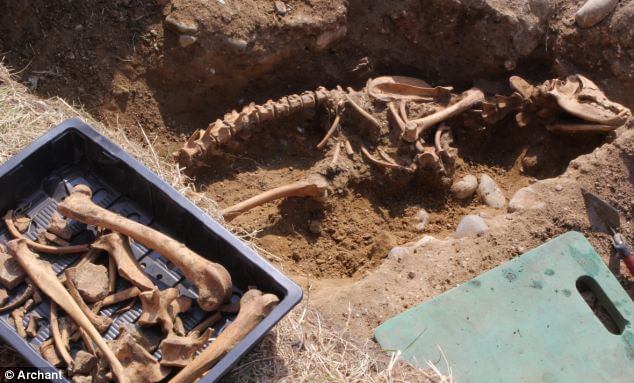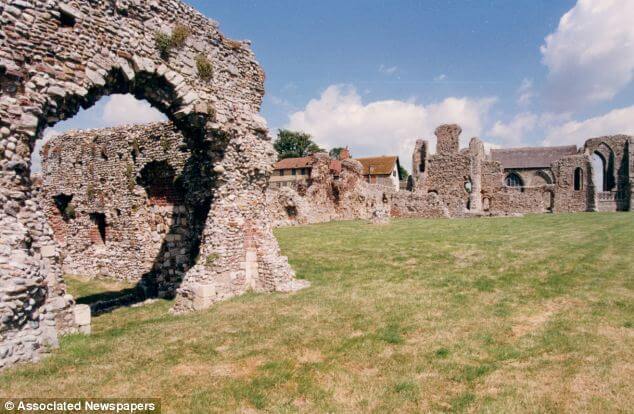
Hell Hound Found: Bones of An Ancient Huge Hound Found At Ruined Abbey
The skeleton of a huge hound believed to have terrorised villagers four centuries ago has been found in a ruined abbey.
By: Paul Harris | Daily Mail
Key Takeaways
- According to folklore, Black Shuck terrorised East Anglia in 16th century
- He towered at seven feet tall, with flaming red eyes and shaggy black hair
- Now, remains of legendary hound may have been unearthed during a dig
- Bones found by archaeologists among ruins at Leiston Abbey in Suffolk
- They belong to ‘male dog’, standing at seven feet tall and weighing 200lbs
- Experts are currently carrying out radio carbon dating tests on remains
It roamed the countryside spreading death and terror – a giant, ferocious hell-hound with flaming eyes and savage claws.
For centuries, the beast that came to be known as Black Shuck struck fear into the hearts of all who crossed its path.
Just a single glimpse was enough to impart a fatal curse; the briefest encounter sufficient to suck the life from any hapless victim.
One thing, however, has always been absent from the many tales of the dog-like entity and its sinister appearances in the East of England flatlands: A single fact.

Now that may be about to change with an answer to the question: Did it exist only in folklore … or was it flesh and blood?
Yesterday, 500 years after Black Shuck first went on the prowl, archaeologists were examining the skeleton of a 7ft long dog unearthed in the remains of an ancient abbey.
It was discovered a few miles from two churches where Black Shuck is said to have killed worshippers during an almighty thunderstorm in August 1577.
What’s more, it appears to have been buried in a shallow grave at precisely the same time as Shuck is said to have been on the loose, primarily around Suffolk and the East Anglia region.

Experts will subject the bones and surrounding material to 21st century dating techniques.
But first, the legend. The beast’s most celebrated attack began at Holy Trinity church, Blythburgh. A clap of thunder burst open the church doors and a hairy black ‘devil dog’ came snarling in.
It ran through the congregation, killing a man and boy and causing the church steeple to fall through the roof. Scorch marks still visible on the church doors are purported to have come from Shuck’s claws as it fled.
Local verse records the event thus: ‘All down the church in the midst of fire, the hellish monster flew, and, passing onward to the quire, he many people slew.’
Next stop was 12 miles away in Bungay, where two worshippers were killed at St Mary’s church. One was left shrivelled ‘like a drawn purse’ as he prayed.


In his 1577 pamphlet A Straunge And Terrible Wunder, the Rev Abraham Fleming told how the Satan-like beast came ‘running all along down the body of the church with great swiftnesse and incredible haste, among the people, in a visible fourm and shape’, wringing the necks of two parishioners as they knelt.
Spookily, a later work reveals: ‘Although his howling makes the hearer’s blood run cold, his footfalls make no sound.’
Subsequent appearances of Shuck – a name believed to derive either from an old English word for demon, or from local dialect meaning ‘shaggy’ – have immortalised it.
An image of Black Shuck is incorporated in Bungay’s coat of arms, and the nickname for equally legendary Bungay Town FC is the Black Dogs.

The bones uncovered in the ruins of Leiston Abbey, Suffolk, were first found by archaeological group Dig Ventures in a project last year.
‘The story of Black Shuck has to have originated from somewhere and, who knows, it could have originated from the dog which was buried here’ – Brendon Wilkins
Painstaking work revealed the skeleton of an extremely large dog.
Estimates suggest it would have weighed more than 14 stone and stood 7ft tall on its hind legs.
The grave was less than 20 inches deep and unmarked. Pottery fragments found at the same level date from the height of Shuck’s alleged reign.
Radio carbon dating tests will now give an exact age for the bones, results that will serve either to enhance the shaggy dog stories – or perhaps to support the far less entertaining theory that here lies a 16th century abbot’s beloved old hunting dog.
* * *
NEXT UP!
Giant “Skeletons of Enormous Size” Discovered In New Mexico – New York Times Article From 1902
Along time ago ― about a century ― a secret society discovered an incredible cave hidden beneath the Earth’s surface. Inside the cave, were several giants of antiquity, apparently alive, but in a state of alternative-animation.
We might think that we really know the truth about all of Earth’s history, but no, there are undoubtedly many mysteries that still deserve to be investigated and the unexplained file of “sleeping giants in stasis chambers” is significantly one of them.
* * *
READ MORE: Batman Existed In Mesoamerican Mythology & His Name Was Camazotz
Read more on Trending Mythology News: Experts Claim That Moses Did Cross The Read Sea, After Finding The Egyptian Army Underwater
Telegram: Stay connected and get the latest updates by following us on Telegram!
We’d love to hear from you! If you have a comment about this article or if you have a tip for a future Collective Spark Story please let us know below in the comment section.
